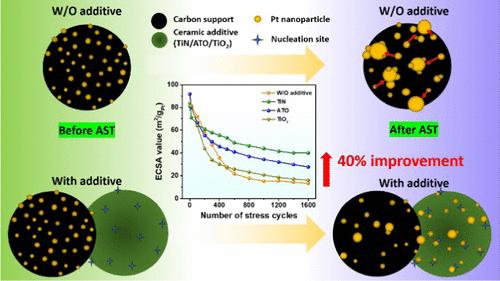当前位置:
X-MOL 学术
›
ACS Appl. Mater. Interfaces
›
论文详情
Our official English website, www.x-mol.net, welcomes your
feedback! (Note: you will need to create a separate account there.)
An Effective Route to Enhance Pt/C Electrocatalyst Durability through Addition of Ceramic Nanoparticles to Facilitate Pt Redeposition
ACS Applied Materials & Interfaces ( IF 8.3 ) Pub Date : 2024-11-19 , DOI: 10.1021/acsami.4c10430 Vahid Karimi, Per Morgen, Saso Gyergyek, Raghunandan Sharma, Shuang Ma Andersen
ACS Applied Materials & Interfaces ( IF 8.3 ) Pub Date : 2024-11-19 , DOI: 10.1021/acsami.4c10430 Vahid Karimi, Per Morgen, Saso Gyergyek, Raghunandan Sharma, Shuang Ma Andersen

|
Platinum particle growth during long-term operations is one of the well-known bottlenecks offsetting the performance and stability of Pt-based electrocatalysts in polymer electrolyte membrane (PEM) fuel cells and PEM water electrolyzers. In this research, the addition of certain ceramic nanoparticulate additives to the catalyst ink was evaluated as a means of improving the electrochemical stability of a carbon-supported platinum (Pt/C) electrocatalyst in gas diffusion electrodes (GDEs) during an accelerated stress test (AST). GDEs prepared using three nanoparticulate ceramic additives (TiN, ATO, and TiO2) with three loadings (replacing 5, 10, and 15 wt % of the catalyst) were studied for their electrochemical performance, i.e., the initial electrochemical surface area (ECSA) and stability during AST in a liquid cell. TiN appeared to be an optimal additive among the three to (i) improve the stability by ∼40% during 1600 cycles, (ii) prohibit Pt nanoparticle agglomeration due to coalescence and Ostwald ripening, and (iii) reduce Pt dissolution during the AST, without compromising a high initial ECSA. The fundamental mechanism lies in the fact that the ceramic nanoparticles can act as additional nucleation sites for redeposition of the dissolved Pt during AST; X-ray photoelectron spectroscopy (XPS) indicates strong interactions between platinum and ceramic nanoparticles. Eventually, the superior sample was used as the cathode catalyst in an electrolyzer to compare the electrochemical performance with that of a commercial Pt/C sample. As confirmed by single-cell tests in this research, the method studied and the associated concept here to enhance the durability of Pt-based electrocatalysts are facile and scalable and hence may be readily adopted by relevant stakeholders.
中文翻译:

通过添加陶瓷纳米颗粒促进 Pt 再沉积来提高 Pt/C 电催化剂耐久性的有效途径
铂颗粒在长期运行期间的生长是众所周知的瓶颈之一,它抵消了聚合物电解质膜 (PEM) 燃料电池和 PEM 水电解槽中 Pt 基电催化剂的性能和稳定性。在这项研究中,评估了在催化剂墨水中添加某些陶瓷纳米颗粒添加剂作为在加速应力测试 (AST) 期间提高碳负载铂 (Pt/C) 电催化剂在气体扩散电极 (GDE) 中电化学稳定性的一种手段。研究了使用三种纳米颗粒陶瓷添加剂(TiN、ATO 和 TiO2)制备的具有三种负载量(替代 5、10 和 15 wt % 催化剂)制备的 GDE 的电化学性能,即初始电化学表面积 (ECSA) 和液体电池中 AST 期间的稳定性。TiN 似乎是这三者中的最佳添加剂,以 (i) 在 1600 次循环中将稳定性提高 ∼40%,(ii) 禁止 Pt 纳米颗粒由于聚结和 Ostwald 成熟而聚集,以及 (iii) 减少 AST 期间的 Pt 溶解,而不会影响高初始 ECSA。基本机制在于陶瓷纳米颗粒可以作为额外的成核位点,在 AST 过程中重新沉积溶解的 Pt;X 射线光电子能谱 (XPS) 表明铂和陶瓷纳米颗粒之间存在强相互作用。最终,将优质样品用作电解槽中的阴极催化剂,以比较电化学性能与商业 Pt/C 样品的电化学性能。 正如本研究中的单电池测试所证实的那样,本研究的方法和相关概念旨在提高 Pt 基电催化剂的耐用性是简单且可扩展的,因此可能很容易被相关利益相关者采用。
更新日期:2024-11-20
中文翻译:

通过添加陶瓷纳米颗粒促进 Pt 再沉积来提高 Pt/C 电催化剂耐久性的有效途径
铂颗粒在长期运行期间的生长是众所周知的瓶颈之一,它抵消了聚合物电解质膜 (PEM) 燃料电池和 PEM 水电解槽中 Pt 基电催化剂的性能和稳定性。在这项研究中,评估了在催化剂墨水中添加某些陶瓷纳米颗粒添加剂作为在加速应力测试 (AST) 期间提高碳负载铂 (Pt/C) 电催化剂在气体扩散电极 (GDE) 中电化学稳定性的一种手段。研究了使用三种纳米颗粒陶瓷添加剂(TiN、ATO 和 TiO2)制备的具有三种负载量(替代 5、10 和 15 wt % 催化剂)制备的 GDE 的电化学性能,即初始电化学表面积 (ECSA) 和液体电池中 AST 期间的稳定性。TiN 似乎是这三者中的最佳添加剂,以 (i) 在 1600 次循环中将稳定性提高 ∼40%,(ii) 禁止 Pt 纳米颗粒由于聚结和 Ostwald 成熟而聚集,以及 (iii) 减少 AST 期间的 Pt 溶解,而不会影响高初始 ECSA。基本机制在于陶瓷纳米颗粒可以作为额外的成核位点,在 AST 过程中重新沉积溶解的 Pt;X 射线光电子能谱 (XPS) 表明铂和陶瓷纳米颗粒之间存在强相互作用。最终,将优质样品用作电解槽中的阴极催化剂,以比较电化学性能与商业 Pt/C 样品的电化学性能。 正如本研究中的单电池测试所证实的那样,本研究的方法和相关概念旨在提高 Pt 基电催化剂的耐用性是简单且可扩展的,因此可能很容易被相关利益相关者采用。


















































 京公网安备 11010802027423号
京公网安备 11010802027423号